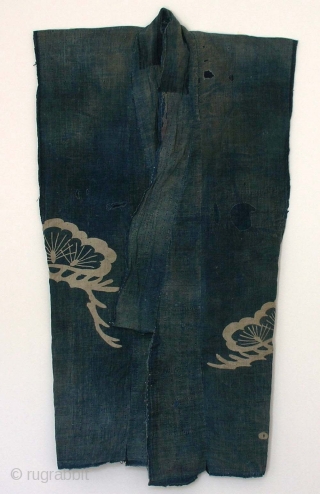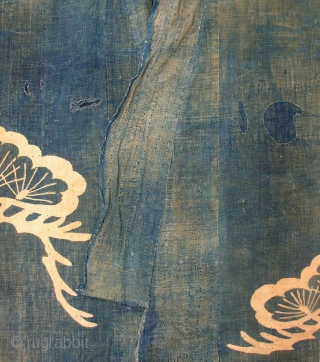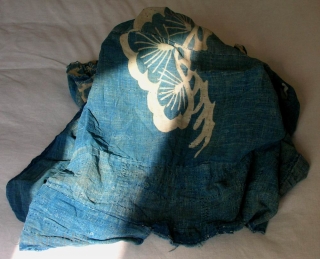Back
Yogi Boro, Japan, Meiji (circa 1880), cm 135x81. Yogi (literally ‘night wear’) can be defined as a ‘sleeping kimono’ or a ‘kimono-shaped bedding’. Because they were large, thick, soft robes, the yogi solved the problem of night time drafts by wrapping all around the sleeper. It was meant to fit tightly around the shoulders and neck, providing excellent protection against the winter cold. Considerably wider than an ordinary kimono, the yogi had an extra panel of cloth down the centre of the back. They were always thickly padded with heavy cotton wadding (they might have weighted as much as 15 pounds!), just like a futon. a fundamental component of a bride’s trousseau, it often shows auspicious motifs, all obtained with a freehand paste-resist decoration (tsutsugaki). The present object was a former yogi that experienced some heavy use, had its padding and the sleeves removed, and was then possibly used as extra bedding cover or to warm up people sitting around the fireplace during the long winter evenings. It had been mended and patched, and these textiles are referred in Japan to as 'boro', or rags. The outside still displays an impressive ‘tsutsugaki’ design called ‘shochikubai’, or ‘the three winter friends’ a composition made of pine (eternity), bamboo (integrity) and plum (cleverness) blossoms, that all together symbolize vitality and courage. This collage-like construction of Edo and Meiji era hand-spoon and hand-woven fabrics and patches offers us a veritable encyclopedia of cotton indigo from those periods. Condition of course plays no role with ‘boro’, and they should be judged upon their visual impact, mainly. This is surely a truly great object in this respect, and a lovely thing to own, i would dare to say…
price:
SOLD
- Home
- Antique Rugs by Region
- Category
- Profiles
- Post Items Free
- Albums
- Benaki Museum of Islamic Art
- Budapest: Ottoman Carpets
- Gulbenkian Museum
- Islamic Carpets. Brooklyn
- Islamic Textiles. Brooklyn
- Konya Museum: Rugs
- MKG, Hamburg
- MMA: Caucasian Carpets
- MMA: Mamluk Carpets
- MMA: Mughal Indian Carpets
- MMA: Ottoman Carpets
- MMA: Safavid Persian Carpets
- MMA: Turkmen Rugs
- McCoy Jones Kilims
- Ottoman textiles. Met
- Philadelphia Museum
- Rugs and Carpets: Berlin
- Seljuqs at the Met
- TIEM, Istanbul: Carpets
- V&A: Classical Carpets
- Vakiflar Carpets: Istanbul
- Baluch Rugs: Indianapolis
- Gallery Exhibitions
- Jaf an Exhibition
- Alberto Levi Gallery
- Andean Textile
- Christie's London: 2016
- Francesca Galloway
- HALI at 40
- ICOC Washington, DC 2018
- Jajims of the Shahsavan
- London Islamic Week April, 2018
- Mongolian Felts
- Navajo Rugs: JB Moore
- Persian Piled Weavings
- SF Tribal & Textile Art Show 2020
- SF Tribal 2019
- Sotheby's: C. Alexander
- Turkish Prayer Rugs
- Turkmen Main Carpets ICOC 2007












